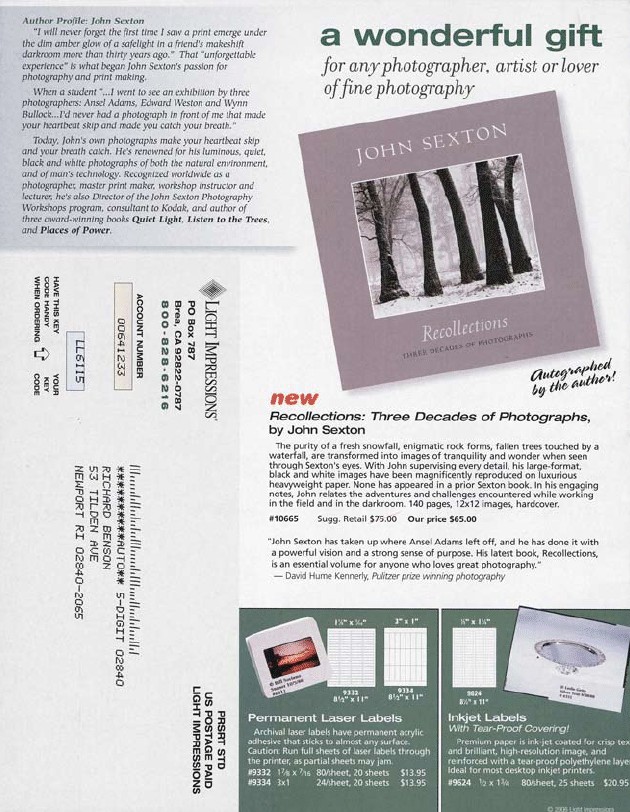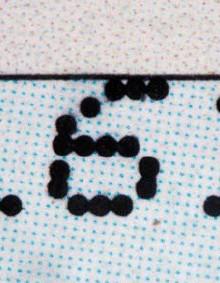- Relief printing
- Intaglio and planographic printing
- Color printing
- Bits and pieces
- Early photography in silver
- Non-silver processes
- Modern photography
- Color notes
- Color photography
- Photography in ink: relief and intaglio printing
- Photography in ink: planographic printing
- Digital processes
- Where do we go from here?
Digital everything

Web photo offset print. Light Impressions Company. Light Impressions mail-order catalog, back cover. 2006. 10 1/8 x 8 1/8" (25.7 x 19.7 cm). The Museum of Modern Art, New York. Gift of Richard Benson. © Light Impressions.
This is the back cover of a catalog that I received the week I wrote this page. I needed something to show the pervasiveness of the computer, and I could have picked up almost any catalog that arrived in the mail (it’s close to Christmas, so there are a lot of them). This particular one is from Light Impressions, a firm that sells archival material for photographic preservation. The first thing to be said is that I was the second human being to handle this booklet. The first was the postman who put it in my mailbox, and as I took it out, I became the second. People designed it (using computers), presses printed and even bound it (also while controlled by computers), and the U.S. Postal Service delivered it to me, but nowhere in that process did a person touch any part of it. Not only has it remained pure and unsullied by the unpredictable human being but this cheap throwaway catalog, along with thousands of others, is better made than most books ever were.

Enlargement of Web photo offset print. Light Impressions Company. Light Impressions mail-order catalog, back cover. 2006. 10 1/8 x 8 1/8" (25.7 x 19.7 cm). The Museum of Modern Art, New York. Gift of Richard Benson. © Light Impressions. Although printed at high speed on a web press, and using a halftone pattern generated by the computer, the dot pattern shown in this detail has remained the same for the seventy years or so in which process-color printing with halftones has been common.
The reproductions are crisp and, when clothing or household goods are being harped, the colors are brilliant. Those of us who cling to the past should be absolutely clear that almost everything about printing is better now than it ever was before, and that this is thanks to today’s remarkable digital tools. I reproduce the back cover because it shows the small pale-yellow and pale-blue rectangles in which code numbers have been printed. Those numbers are unique, and define this catalog as the specific one that was sent to Richard Benson to help him buy stuff. The numbers link to huge databases, generated to place me in a group of likely clients for this company’s products. These databases in turn are part of an even larger, nebulous data entity comprising the aggregate of databases from many companies selling many different products.

Enlargement of Web photo offset print. Light Impressions Company. Light Impressions mail-order catalog, back cover. 2006. 10 1/8 x 8 1/8" (25.7 x 19.7 cm). The Museum of Modern Art, New York. Gift of Richard Benson. © Light Impressions. The information customizing the catalog for a specific recipient has been printed on top of the conventional halftone. The coarse dots have been digitally generated, and are printed in poor register, but the numbers they display have changed for every single copy in the thousands of the edition.
A number of businesses, instead of selling products, instead deal only in sales data, which they market to those who still sell hard goods. We are part of this web, and even though it makes us nervous we happily take advantage of its benefits. To top it all off, the cover of the catalog has a photograph on it. The history of that picture is as follows: John Sexton made a negative and printed it; the print was scanned, plated, and printed in ink as the cover of his book; that cover was then scanned, plated, and printed on the catalog; I got the catalog, scanned it, tuned it, and sent it to the printer of my own book. Even after all this, the picture looks pretty good. The union of photography, computer, paper, and press is an absolute miracle in its present state.

